We’re now in the midst of summer and many campers and hikers strolling through Penn’s Woods can enjoy a treat along the way.
Wild blueberries (Vaccinium species) and huckleberries (Gaylussacia species) are in season, providing a tasty snack for humans and wildlife alike.
Pennsylvania Blueberries
Pennsylvania has four species of blueberries, including the highbush blueberry (pictured above), which is our tallest blueberry and common in wet woods, thickets and stream sides.
The other three blueberry species are generally called “lowbush blueberries” due to their short stature.
Lowbush blueberries are widespread in Pennsylvania parks and forests along trails and in open, dry oak communities. They are:
- Low sweet blueberry (V. angustifolium)
- Lowbush blueberry (V. pallidum)
- Sour-top blueberry (V. myrtilloides), which is less common and named for its sour-tasting fruit
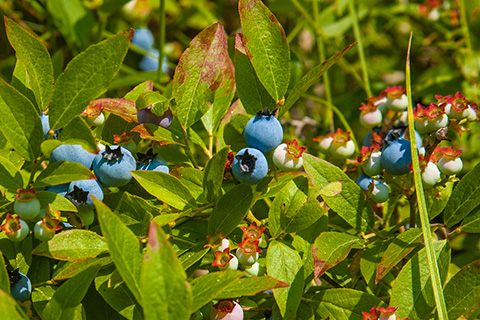
Low sweet blueberry (photo by Paul VanDerWerf)
Pennsylvania also has several other Vaccinium species, including the deerberry (V. stamineum) which has a green to purplish, sour and thick-skinned fruit. It may not taste as good as a fresh blueberry but is prized in the southern U.S. in jellies and pies.
Native Cranberries
The last two Vacciniums are our native cranberries, the large (V. macrocarpon) and the small (V. oxycoccus). The cranberries are denizens of bogs and peaty wetlands, ripening in the fall.
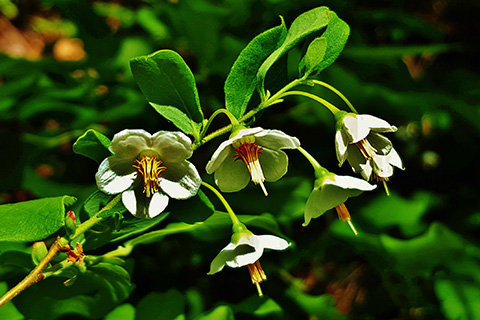
Deerberry flowers (photo by Matthew Beziat)
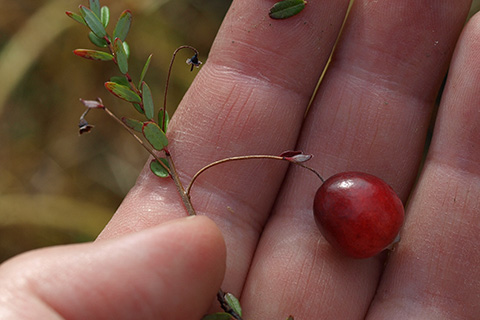
Large cranberry (photo by Vilseskogen)
Is it a blueberry or a huckleberry?
The unwary hiker browsing on summer blueberries may come across of patch of blueberries that look odd, being more black than blue. These are black huckleberries (G. baccata), whose fruits are similar in size to blueberries, but have noticeable seeds (blueberry seeds are small and easily go unnoticed).
Aside from the color of the fruit, an easy way to confirm a black huckleberry is to hold a leaf in the sunlight, as it will sparkle as the light hits hundreds of small resin dots on the leaves. Like blueberries, huckleberries are sweet too.
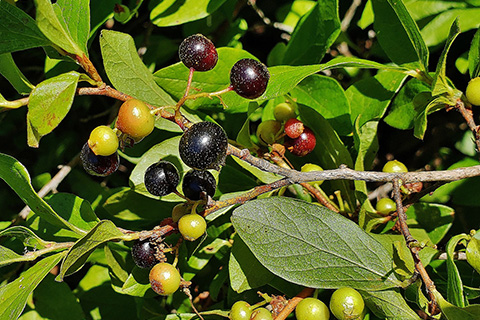
Black huckleberry (photo by Matt Beziat)
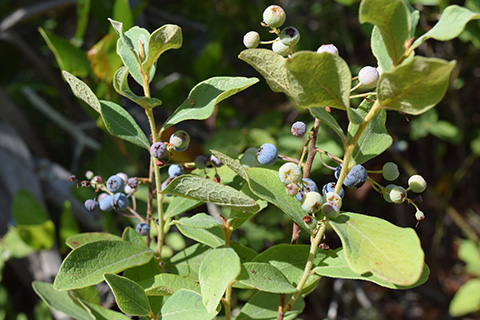
Dangleberry (photo by Adam Arendell)
Another Gaylussacia species is the dangleberry, also known as the blue huckleberry (G. frondosa), as it is similar in color to blueberries and is sweet and tasty. Like the black huckleberry, it has resin dots on its leaves, but only on the lower surface.
The other Pennsylvania huckleberry is the box huckleberry (G. brachycera), occurring in a few locations in the state. Box huckleberry is unique for several reasons -- it lacks the resin dots of the other two huckleberries and its leaves resemble those of the ornamental boxwood shrub. Pennsylvania’s populations of box huckleberry are believed to be slowly growing colonies, with one possibly more than 8,000 years old.
A younger colony, estimated at 1,300 years, can be visited at the Hoverter and Sholl Box Huckleberry Natural Area in Tuscarora State Forest, which is a Registered Natural Landmark.
Pennsylvania once had a fourth huckleberry species, the dwarf huckleberry (G. dumosa), now believed to be extirpated from the commonwealth.
Pennsylvania’s blueberries and huckleberries are abundant, so take a walk in Penn’s Woods, do your research, and enjoy a healthy snack or bring a bucket and take some home!